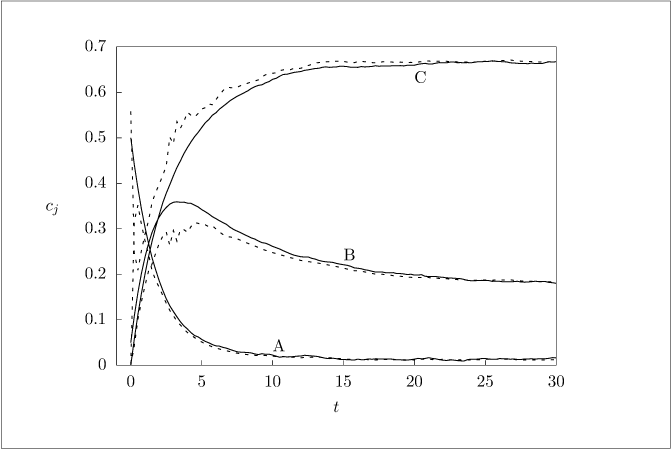Figure 4.5:
Evolution of the state (solid line) and MHE state estimate (dashed line).

Code for Figure 4.5
Text of the GNU GPL.
main.m
1
2
3
4
5
6
7
8
9
10
11
12
13
14
15
16
17
18
19
20
21
22
23
24
25
26
27
28
29
30
31
32
33
34
35
36
37
38
39
40
41
42
43
44
45
46
47
48
49
50
51
52
53
54
55
56
57
58
59
60
61
62
63
64
65
66 | % This file simulates the Batch Reactor Example (3.2.1) from Haseltine
% & Rawlings (2005)
% MHE is implemented to this example and it is shown that it
% performs better than EKF and UKF when a poor prior is used.
mpc = import_mpctools();
% States: x = [Ca Cb Cc]'
% Total pressure is measured (C = RT*[1 1 1])
Nsim = 120;
pars = batchreactor(Nsim);
Nx = pars.Nx;
Ny = pars.Ny;
Nw = pars.Nw;
Nv = pars.Nv;
Nt = 10;
xsim = pars.xsim;
ysim = pars.ysim;
% Pick stage costs.
Q = pars.Q;
R = pars.R;
sig_w = pars.sig_w;
sig_v = pars.sig_v;
lfunc = @(w, v) (w'*w)/sig_w.^2 + (v'*v)/sig_v.^2;
l = mpc.getCasadiFunc(lfunc, [Nw, Nv], {'w', 'v'}, {'l'});
% Now build MHE solver.
mhepar = struct('Pinv', mpctools.spdinv(pars.P), 'x0bar', pars.xhat0);
N = struct('x', Nx, 'w', Nw, 'y', Ny, 't', Nt);
lb = struct('x', zeros(Nx, Nt + 1)); % Concentrations are nonnegative.
ub = struct('x', 10*ones(Nx, Nt + 1)); % Concentrations shouldn't be this high.
buildsolvertime = tic();
solver = mpc.nmhe('f', pars.f, 'l', l, 'h', pars.h, 'y', ysim(:,1:(Nt + 1)), ...
'N', N, 'lb', lb, 'ub', ub, 'par', mhepar, ...
'priorupdate', 'smoothing', 'verbosity', 0);
% Loop.
xhat = NaN(Nx, Nsim + 1);
yhat = NaN(Ny, Nsim + 1);
tic();
for t = 1:(Nsim + 1)
% Get new measurement or extend horizon.
if t > Nt + 1
solver.newmeasurement(ysim(:,t));
else
solver.truncatehorizon(t - 1);
end
% Solve MHE problem and save state estimate.
solver.solve();
if ~isequal(solver.status, 'Solve_Succeeded')
warning('Solver failure at time %d!', t);
break
end
solver.saveestimate(); % Stores estimate to history and updates prior.
xhat(:,t) = solver.history(1).xhat(:,end);
yhat(:,t) = solver.history(1).yhat(:,end);
end
% Make a plot.
pars.reactorplot(xsim, xhat, ysim, yhat, pars.yclean, pars.Delta);
|
batchreactor.m
1
2
3
4
5
6
7
8
9
10
11
12
13
14
15
16
17
18
19
20
21
22
23
24
25
26
27
28
29
30
31
32
33
34
35
36
37
38
39
40
41
42
43
44
45
46
47
48
49
50
51
52
53
54
55
56
57
58
59
60
61
62
63
64
65
66
67
68
69
70
71
72
73
74
75
76
77
78
79
80
81
82
83
84
85
86
87
88
89
90
91
92
93
94
95
96
97
98
99
100
101
102
103
104
105
106
107
108
109
110
111
112
113
114
115
116
117
118
119
120
121
122
123
124
125
126
127
128
129 | function pars = batchreactor(Nsim)
% pars = batchreactor(Nsim)
%
% Returns a struct of batch reactor parameters to avoid duplication across
% MHE, EKF, and UKF scripts.
narginchk(1, 1);
mpc = import_mpctools();
% Sizes.
Delta = 0.25;
Nx = 3;
Ny = 1;
Nw = Nx;
Nv = Ny;
% Random variable standard deviations.
sig_v = 0.25; % Measurement noise.
sig_w = 0.001; % State noise.
sig_p = 0.5; % Prior.
P = sig_p.^2*eye(Nx);
Q = sig_w.^2*eye(Nw);
R = sig_v.^2*eye(Ny);
% Get model functions.
plant = mpc.getCasadiIntegrator(@batch_model, Delta, [Nx], {'x'});
frk4 = mpc.getCasadiFunc(@(x) batch_model(x), [Nx], {'x'}, {'frk4'}, ...
'rk4', true(), 'Delta', Delta, 'M', 4);
f = mpc.getCasadiFunc(@(x, w) frk4(x) + w, [Nx, Nw], {'x', 'w'}, {'f'});
h = mpc.getCasadiFunc(@measurement, [Nx], {'x'}, {'h'});
% Choose prior.
xhat0 = [1; 0; 4];
x0 = [0.5; 0.05; 0.0];
% Simulate the system to get data.
randn('state', 0);
w = sig_w*randn(Nw, Nsim);
v = sig_v*randn(Nv, Nsim + 1);
xsim = NaN(Nx, Nsim + 1);
xsim(:,1) = x0;
ysim = NaN(Ny, Nsim + 1);
yclean = NaN(Ny, Nsim + 1);
for t = 1:(Nsim + 1)
xsim(:,t) = max(xsim(:,t), 0); % Make sure concentration is nonnegative.
yclean(:,t) = full(h(xsim(:,t)));
ysim(:,t) = yclean(:,t) + v(:,t);
if t <= Nsim
xsim(:,t + 1) = full(plant(xsim(:,t))) + w(:,t);
end
end
t = (0:Nsim)*Delta;
% Get plotting function for convenience.
reactorplot = @reactorplot;
% Package everybody up. Note that this is a quick and dirty approach.
varnames = who();
pars = struct();
for i = 1:length(varnames);
v = varnames{i};
pars.(v) = eval(v);
end
end%function
function dxdt = batch_model(x)
% Nonlinear ODE function.
k1 = 0.5;
km1 = 0.05;
k2 = 0.2;
km2 = 0.01;
cA = x(1);
cB = x(2);
cC = x(3);
rate1 = k1*cA - km1*cB*cC;
rate2 = k2*cB.^2 - km2*cC;
dxdt = [
-rate1;
rate1 - 2*rate2;
rate1 + rate2;
];
end%function
function y = measurement(x)
% Linear measurement function.
RT = 0.0821*400;
y = RT*sum(x);
end%function
function fig = reactorplot(x, xhat, y, yhat, yclean, Delta)
% Make a plot of actual and estimated states.
narginchk(6, 6);
fig = figure();
Nx = 3;
Nt = size(x, 2) - 1;
t = (0:Nt)*Delta;
ax = subplot(2, 1, 2);
hold('on');
plot(t, yclean, '-k', 'DisplayName', 'Actual');
plot(t, yclean, '--c', 'DisplayName', 'Measured');
plot(t, yhat, 'ok', 'DisplayName', 'Estimated');
ylabel('P');
xlabel('t');
legend('Location', 'EastOutside');
set(ax, 'ylim', [10, 35]);
ax = subplot(2, 1, 1);
hold('on');
colors = {'r', 'b', 'g'};
names = {'A', 'B', 'C'};
for i = 1:Nx
plot(t, x(i,:) + 1e-10, ['-', colors{i}], 'DisplayName', ...
sprintf('Actual C_%s', names{i}));
plot(t, xhat(i,:) + 1e-10, ['o', colors{i}], 'DisplayName', ...
sprintf('Estimated C_%s', names{i}));
end
xlabel('t');
ylabel('c_i');
legend('Location', 'EastOutside');
set(ax, 'ylim', [-1, 1.5]);
end%function
|
